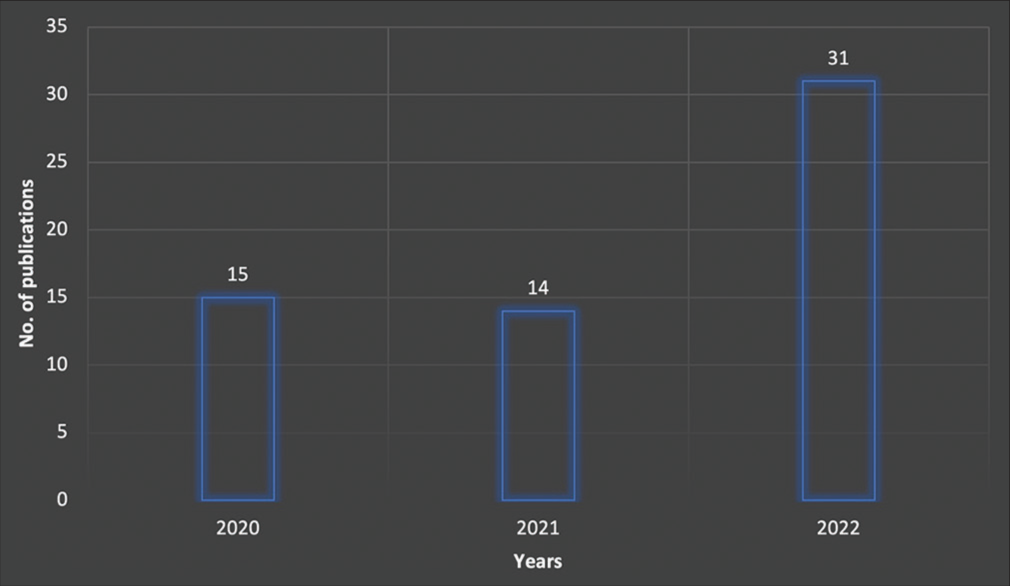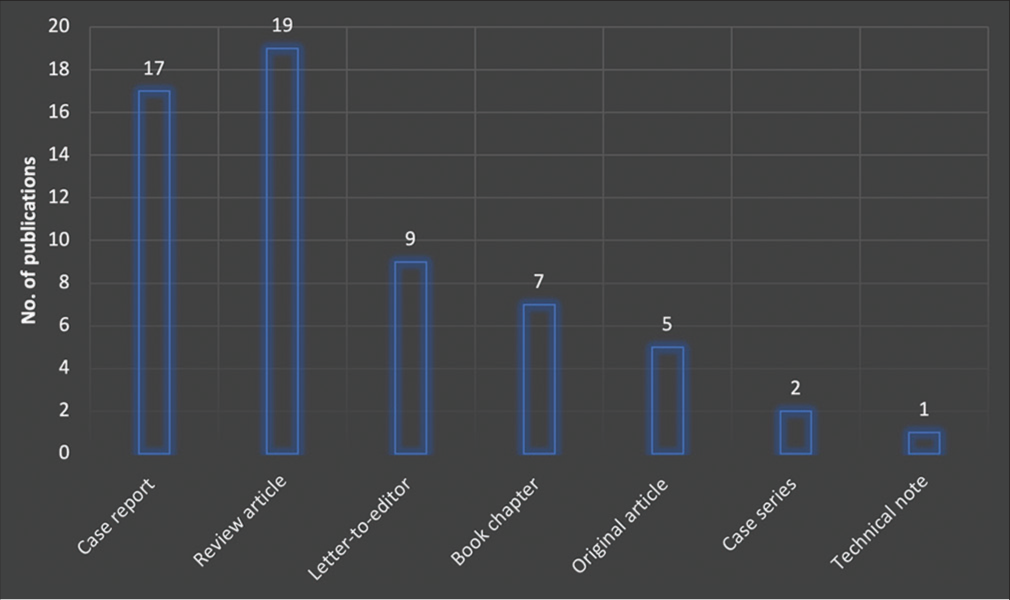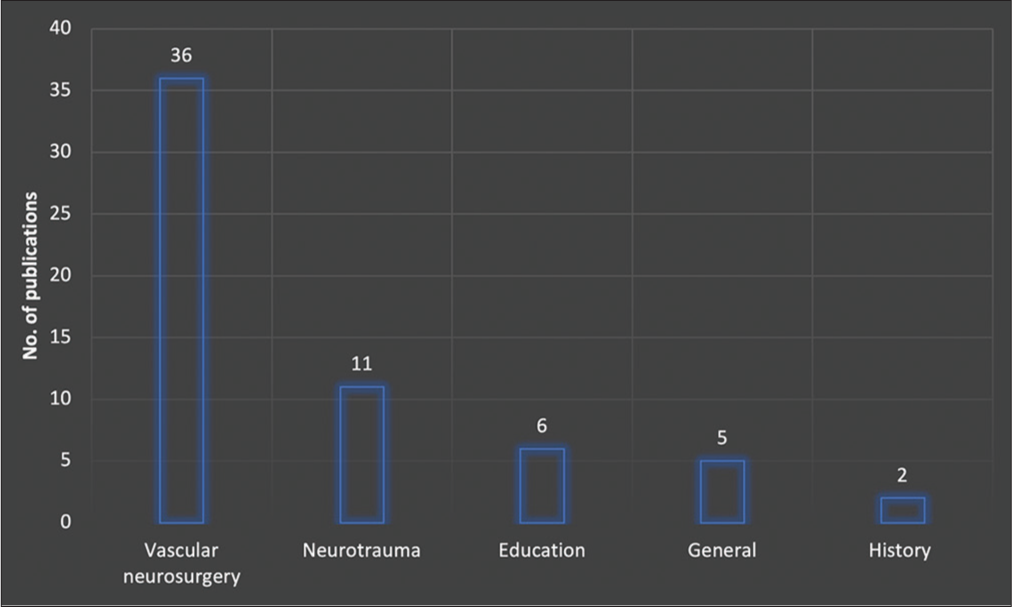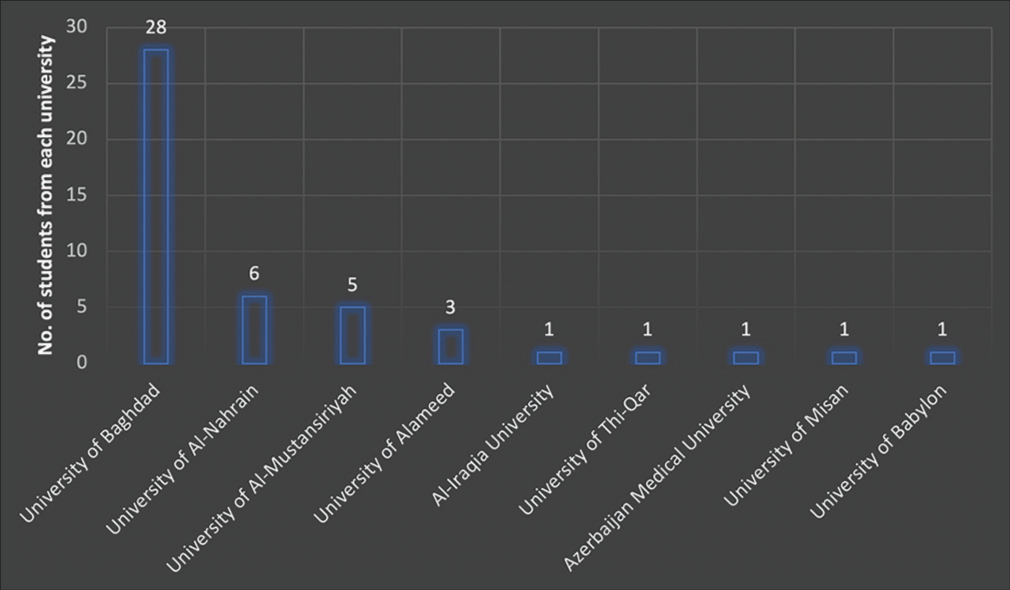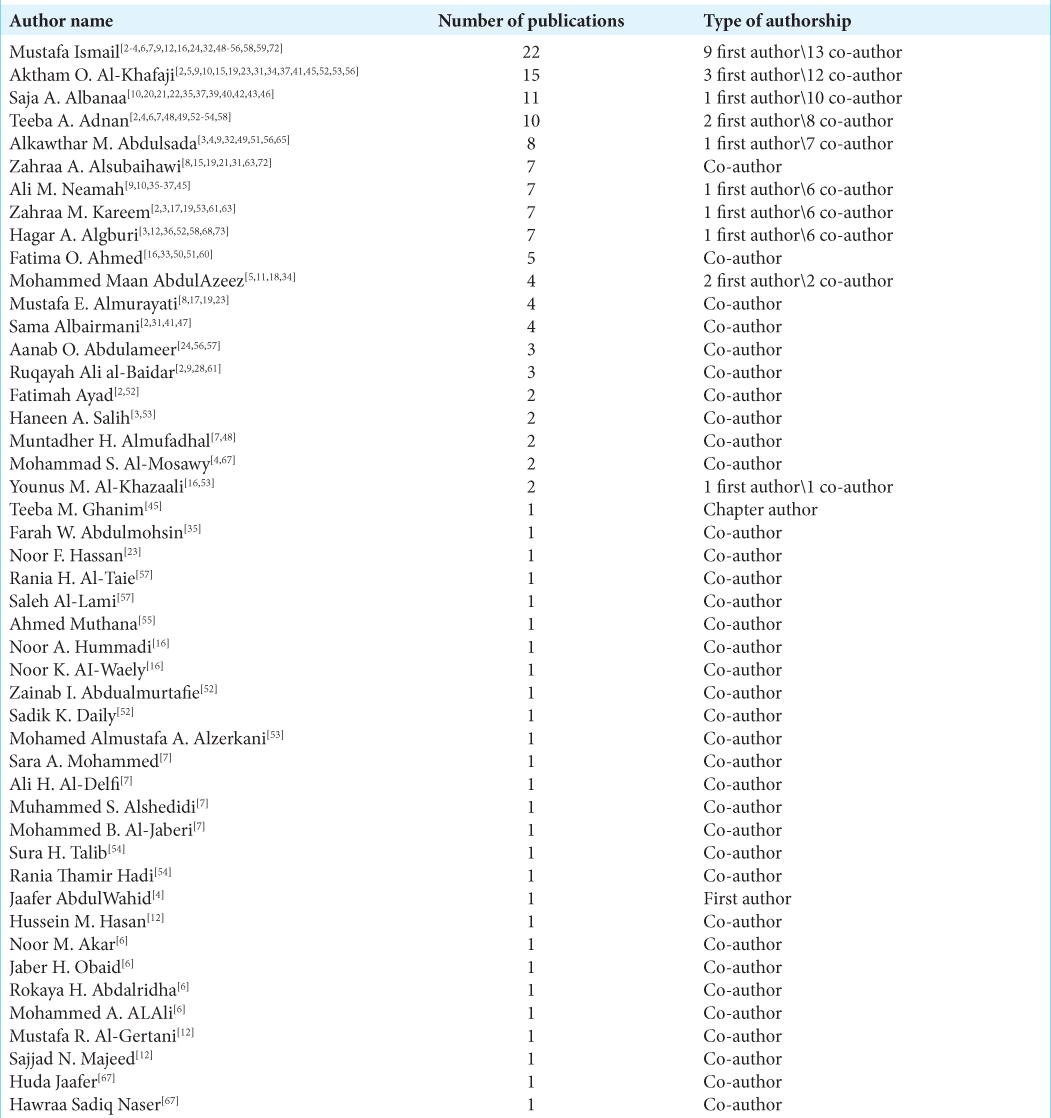- Department of Neurosurgery, University of Baghdad, College of Medicine, Baghdad, Iraq
- Department of Neurosurgery, University of Al-Nahrain, College of Medicine, Baghdad, Iraq,
- Department of Neurosurgery, University of Cincinnati, Cincinnati, United States.
Correspondence Address:
Mustafa Ismail, Department of Neurosurgery, University of Baghdad, College of Medicine, Baghdad, Iraq.
DOI:10.25259/SNI_1018_2022
Copyright: © 2023 Surgical Neurology International This is an open-access article distributed under the terms of the Creative Commons Attribution-Non Commercial-Share Alike 4.0 License, which allows others to remix, transform, and build upon the work non-commercially, as long as the author is credited and the new creations are licensed under the identical terms.How to cite this article: Mustafa Ismail1, Hagar A. Algburi1, Younus M. Al-Khazaal2, Sadik K. Daily1, Huda E. Mohsin1, Huda Jaafar1, Jaafer AbdulWahid2, Norberto Andaluz3, Samer S. Hoz3. Academic productivity of Iraqi medical students in the field of neurosurgery: A literature review. 10-Feb-2023;14:52
How to cite this URL: Mustafa Ismail1, Hagar A. Algburi1, Younus M. Al-Khazaal2, Sadik K. Daily1, Huda E. Mohsin1, Huda Jaafar1, Jaafer AbdulWahid2, Norberto Andaluz3, Samer S. Hoz3. Academic productivity of Iraqi medical students in the field of neurosurgery: A literature review. 10-Feb-2023;14:52. Available from: https://surgicalneurologyint.com/surgicalint-articles/12146/
Abstract
Background: The interest in clinical research is growing worldwide, and the involvement of medical students in academic and clinical research is increasing. Medical students in Iraq have started to focus on academic activities. However, this trend is in its infancy due to limited resources and the war burden. Their interest in the field of Neurosurgery has been evolving recently. This is the first paper that aims to assess the status of the academic productivity of Iraqi medical students within the neurosurgical field.
Methods: We searched the PubMed Medline database and Google scholar between January 2020 and December 2022 with a different combination of keywords. Additional results were obtained by individually searching for all the medical universities in Iraq that participated in the neurosurgical literature.
Results: Between January 2020 and December 2022, 60 neurosurgical publications included Iraqi medical students. 47 Iraqi medical students from 9 universities (the University of Baghdad 28 students, followed by 6 students from the University of Al-Nahrain, and others) were involved in these 60 neurosurgery publications. The topics of these publications are “vascular neurosurgery” (n = 36) followed by “neurotrauma” (n = 11).
Conclusion: Academic productivity of Iraqi medical students in the field of Neurosurgery has surged in the last 3 years. In the past 3 years, 47 Iraqi medical students from nine different Iraqi universities contributed to sixty international neurosurgical publications. However, there are challenges that are required to be tackled to establish a research-friendly environment despite wars and restrained resources.
Keywords: Academic productivity, Iraq, Medical education, Medical students, Neurosurgery
INTRODUCTION
Clinical research represents one of the measures of development for the institutes and communities. This impacted the tendency to increase academic productivity over the last decades. Alongside other databases of medical publications, PubMed, for example, has reached more than eight hundred thousand research papers added annually.[
Research within the medical school is not only a requirement for educational institutes but dramatically benefits medical students regarding their medical knowledge, career development, and specialty choice.
Medical students’ research production has increased steadily over time, particularly in the field of neurosurgery.[
This is the first paper that aims to explore the quality and quantity of the academic productivity of medical students in Iraq in the field of neurosurgery over the past 2 years.
MATERIALS AND METHODS
We conducted a search in the PubMed Medline database and Google scholar by the following combined keywords: “Neurosurgery” “Neurological surgery” “Iraq” “Iraqi” “Medical students.” The results were filtered to include papers published between January 2020 and December 2022. We included articles that involved medical students from Iraqi universities who published in the field of neurosurgery, and we excluded articles related to non-Iraqi medical students. Afterward, a search by author name was done for all known medical students who participated in research activity from Iraq. In addition, direct reach out to universities and medical students is performed to verify their affiliation. Information on these papers was extracted and analyzed according to the following parameters: author name, medical college/ university, city/governate, stage at the time of publication (all medical colleges in Iraq have 6 years bachelor program), the topic of the publication (general neurosurgery, neurosurgery education, history of neurosurgery, neurotrauma, vascular neurosurgery, and others), the type of the publication (original article, literature review, case series, case reports, technical note, letter-to-editor, and book chapter), journal name/specialty/impact factor, and number of medical students in the paper out of the total number of authors.
RESULTS
Between January 2020 and October 2022, 47 medical students from Iraq participated in 60 neurosurgical publications. These publications included 53 published articles and 7 book chapters. Most of the students’ publications were in 2022, including 31 publications, followed by 15 publications in 2020 and 14 in 2021 [
DISCUSSION
The development in the neurosurgical field can be measured with a variety of parameters, with the research activity reflecting a critical aspect of the program, institutional, and national quality of education and health care.[
Moreover, both under and post-graduation of the medical system in Iraq, centrally reflecting on research as a byproduct of the system and individually as a leisure activity; the neurosurgical field is not an apparent exception. There is an urge to get a higher number of publications to get academic promotion and empower curriculum vitae for abroad job applications; nonetheless, recently, amid this reality of research in Iraq, new approaches have emerged, and they focus on developing medical students, and resident primarily through mentorship to bring the research main in neurosurgery into a new level and advance the field.
The number of neurosurgical publications involving Iraqi medical students throughout recent years shows a relatively promising productivity trend. By searching different data databases and selecting the timeframe in 3 years, the results showed 15 projects published in 2020, followed by 14 projects published in 2021. The number has advanced to 23 projects published only in two-thirds of 2022, and the majority of the publications are in vascular neurosurgery. The explanation of most publications within the vascular subspecialty is ignited by the fact that the neurosurgery teaching hospital in Baghdad is the center of cerebrovascular practice in Iraq, and this center constantly welcomes medical students from all over Iraq. Moreover, from 2019 till the present, the status of mentoring medical students in neurosurgery (including research mentoring) is active, and a significant number of those mentors are vascular neurosurgeons with vigorous accomplishments in the field. However, these numbers may be considered small compared to international research productivity related to neurosurgery. Such conditions may be attributed to insufficient research resources, insufficient funding, and the absence of a documentation system in the academic field in Iraq.[
Out of all published studies, neurotrauma was the second most common topic to be highlighted by publications that included medical students, perhaps this is not surprising due to the vast numbers of neurotrauma cases faced by Iraqi neurosurgeons, and the reporting of these cases is still remarkable due to ongoing armed conflicts especially when viewed in the context of a war-afflicted country. Numerous atypical injuries are witnessed on regular bases, including blast bombings and severe penetrating craniofacial injuries caused by unusual grenades such as tear gas canisters.[
Mentorship has been established globally as one critical of the gateways to acquiring and maintaining knowledge, skills, and attitudes; neurosurgery is entangled with a such approach in medical education. In recent years in Iraq, neurosurgery spotted mentorships of medical students, residents, and practicing neurosurgeons. For medical students, it is more vivid and produced a significant change in their learning of neurosurgery academically and technically. Despite all highlighted challenges facing Iraqi research productivity, great efforts are being made to improve the neurosurgical academic productivity in Iraq by medical students through their ambitions and interest in the field. Neurosurgeons provide research opportunities through mentoring students and involving them in research activities. The best example of these opportunities occurred during the COVID-19 pandemic when the country encountered the expansion of “Baghdad Neurosurgery Mentorship” by Dr. Samer S. Hoz; the opportunities came to vast numbers of Iraqi medical students to discover and explore their interest in neurosurgery.[
Furthermore, a possible explanation for increasing medical students’ publications in neurosurgery in 2022 is Surgical Neurology International® (SNI®)-Baghdad neurosurgical online meetings.[
Further, selecting journals for submitting research papers was one of the critical steps in maintaining the students’ neurosurgical research activity. Through the mentorship, direct communication between the mentees and mentors to discuss the journal selection. One of the journal metrics pointed out in the discussion was the journal’s impact factor; however, other equally important metrics were mentioned, which included time from acceptance to publication, article processing charge, the scope of the journal, and the option of open access. The results are that medical students published in neurosurgical journal with variable impact factors; nevertheless, highlighting the impact the paper was taken into consideration as the impact factor metric focus on the citations of the journal articles over a period of time (usually 2 years) and this may not represent the precisely the impact of the paper in the field of medicine. The impact factor does not consider the impact of the clinician who read a paper and used its information in his/her practice.[
The limitation of the current study includes the culture of participation in sub-specialty-related research is a novel approach to learning in Iraq, so we focused on the recent 3 years to address academic productivity. Despite shown development in medical students’ productivity, much effort and the right plans are required to improve the research activity at an internationally comparable level. Furthermore, basic sciences research in neurosurgery was not found in our review because this type of study requires funding and support, which has not existed in Iraq until recently. We emphasize that this issue can be the next step in supporting academia. The funding is required to flourish both academic and clinical types of research, and this can be the prototype for a future national-level strategic plan. That would spark a new era under the motto that research is a need rather than a luxury, even in a war-torn country like Iraq, as this is the only way to build a fair foundation for better education in the future.
CONCLUSION
Academic productivity of Iraqi medical students in the field of neurosurgery has surged in the last 3 years. In the past 3 years, 47 Iraqi medical students from nine different Iraqi universities contributed to sixty international neurosurgical publications. However, it is still improving and with several challenges that are required to be addressed, tackled, and resolved to establish a research-friendly environment despite the consequences of wars and restrained resources.
Declaration of patient consent
Patient’s consent not required as there are no patients in this study.
Financial support and sponsorship
Nil.
Conflicts of interest
There are no conflicts of interest.
Disclaimer
The views and opinions expressed in this article are those of the authors and do not necessarily reflect the official policy or position of the Journal or its management. The information contained in this article should not be considered to be medical advice; patients should consult their own physicians for advice as to their specific medical needs.
References
1. Abdali HA, Hoz SS, Moscote-Salazar LR. Cranial gravitational (Falling) bullet injuries: Point of view. J Neurosci Rural Pract. 2018. 9: 278-80
2. Abdulqader MN, Ismail M, Al-Khafaji AO, Al-Ageely TA, Kareem ZM, Al-Baider RA. Brown-Sequard syndrome associated with a spinal cord injury caused by a retained screwdriver: A case report and literature review. Surg Neurol Int. 2022. 13: 520
3. Abdulsada AM, Kareem ZM, Salih HA, Algburi HA, Ismail M, Hoz SS. Deep motor cortex cavernoma resection supported by navigational intraoperative monitoring: A case report. Romanian Neurosurg. 2022. p. 465-9
4. AbdulWahid J, Ismail M, Al-Mosawy MS, Abdulsada AM, AlAgeely TA, Hoz SS. Ins and outs in deciding a future career in neurosurgery: A medical student’s perspective. Surg Neurol Int. 2022. 13: 530
5. Aktham A, AbdulAzeez MM, Hoz SS. Surgical intervention of intracerebral hematoma caused by ruptured middle cerebral artery aneurysm in neurosurgery teaching Hospital, Baghdad, Iraq. Neurol India. 2020. 68: 124-31
6. Al-Ageely TA, Ismail M, Akar NM, Abdalridha RH, ALAli MA, Obaid JH. Complete bilateral blindness associated with ruptured anterior communicating artery aneurysm: A literature review and illustrative case. Surg Neurol Int. 2022. 13: 551
7. Al-Ageely TA, Ismail M, Mohammed SA, Al-Delfi AH, Alshedidi MS, Al-Jaberi MB. Failure of tandem flow diversion for intracranial aneurysms: Literature review and illustrative case. Surg Neurol Int. 2022. 13: 518
8. Al-Ameri LT, Burhan H, Finjan MA, Eyad M, Kareem ZM, Alsubaihawi ZA, editors. Miscellaneous issues related to neurotrauma. Neurotrauma. Cham: Springer; 2022. p. 149-66
9. Al-Baidar RA, Ismail M, Elamin O, Ahmed MK, Abdulsada AM, Neamah AM. Tangential gunshot wound to the head: A case report with review of literature. Romanian Neurosurg. 2022. p. 470-5
10. Albanaa SA, Al-Sharshahi ZF, Hummadi NA, Al-Waely NK, Alshakarchy RA, Neamah AM. Enlarged anterior communicating artery masquerading as intracranial aneurysm: Case report. Roman Neurosurg. 2020. 34: 455-8
11. Aldelfi SH, Alsaadi SB, AbdulAzeez MM, Musarhad MN, Khudhair MD, Hoz SS. The role of strict patient-positioning during nursing in the management of intracerebral migration of gravitational bullet injury. Roman Neurosurg. 2020. 34: 154-7
12. Algburi HA, Sharma M, Ismail M, Albulaihed SA, Al-Gertani MR, Majeed SN. The coexistence of anterior communicating artery aneurysm and meningioma: A literature review and illustrative case. Surg Neurol Int. 2022. 13: 569
13. Alhillo HT, Arnaout MM, Radhi HS, Al-Dhahir MA, MoscoteSalazar LR, Hoz SS. Direct head injury caused by a tear gas cartridge. Questions on safety: A case report from Iraq and review of the literature. J Clin Neurosci. 2018. 56: 179-82
14. Al-Khafaji AA, Hoz SS, Al-Awadi OM, Al-Sharshahi ZF. Alwitri: The father of modern neurosurgery in Iraq. Surg Neurol Int. 2021. 12: 66
15. Al-Khafaji AO, Al-Sharshahi ZF, Lee RP, Alsubaihawi ZA, Dolachee AA, Hoz SS. Unilateral absence of the internal carotid artery associated with anterior communicating artery aneurysms: Systematic review and a proposed management algorithm. Surg Neurol Int. 2020. 11: 221
16. Al-Khazaali YM, Hummadi NA, Ismail M, Al-Waely NK, Ahmed FO, Hoz SS. Right-sided aortic arch with complex anomalies presented with transient ischemic attack. Surg Neurol Int. 2022. 13: 493
17. Alsaadi SB, Mohammed SA, Kareem ZM, Almurayati M, Hoz SS. Surgical control over superior sagittal sinus injury due to metallic ceiling fan-blade injury. Mustansiriyah Med J. 2020. 19: 34-6
18. Al-Salihi MM, editors. Evolutionary Retrace of the Third Eye. Berlin: Springer; 2020. p. 133-41
19. Al-Sharshahi ZF, Hoz SS, Almurayati ME, Kareem ZM, Ameen Z. Intracisternal papaverine toxicity in anterior circulation aneurysm clipping surgery: A literature review. Roman Neurosurg. 2020. 34: 386-90
20. Al-Sharshahi ZF, Albanaa SA, Jawad AM, Al-Waely NK, Hummadi NA, Hoz SS. Dolichoectatic middle cerebral artery masquerading as cerebral cavernous malformation: A case report and review of literature. Roman Neurosurg. 2020. 16: 498-503
21. Al-Sharshahi ZF, Alsubaihaw ZA, Sabah MA, Albanaa SA, AlAmarah SM, Hoz SS. Basal cisternostomy proper for acute external brain herniation during craniotomy: A case report. Int J Sci Res Hemethodol. 2020. 15: 1-5
22. Al-Sharshahi ZF, Hoz SS, Alrawi MA, Sabah MA, Albanaa SA, Moscote-Salazar LR. The use of non-living animals as simulation models for cranial neurosurgical procedures: A literature review. Chin Neurosurg J. 2020. 6: 24
23. Al-Sharshahi ZF, Salih HR, Aktham AA, Shamkhi MA, Murayati MA, Hassan NF, editors. Letter to the Editor: Cadaver-free simulation training in microneurosurgery: An experience from Iraq. World Neurosurg. 2021. 151: 310-2
24. Al-Smaysim AM, Alhayali WK, Alsaadi SB, Abdulameer AO, Ismail M, Hoz SS. Endoscopic third ventriculostomy: Complications and avoidance. Romanian Neurosurg. 2022. p. 479-82
25. Ausman JI, Epstein N, West JL. Comparative metrics of neurosurgical scientific journals: What do they mean to readers?. Surg Neurol Int. 2020. 11: 169
26. Awad AJ, Sarkiss CA, Kellner CP, Steinberger J, Mascitelli JR, Oermann EK. Impact of neurosurgery medical student research grants on neurosurgery residency choice. World Neurosurg. 2016. 92: 349-52
27. Barnett-Vanes A, Hassounah S, Shawki M, Ismail OA, Fung C, Kedia T. Impact of conflict on medical education: A cross-sectional survey of students and institutions in Iraq. BMJ Open. 2016. 6: e010460
28. Eleni D, Tsianaka MA, Al-Baidar RA, Altaweel MM, Al-Dhahir MA, Al-Sharshahi ZF, editors. Complications, outcomes, and other aspects. Neurotrauma: Multiple-Choice Questions. Berlin: Springer; 2022. p. 121
29. Elsamadicy AA, Sergesketter A, Sampson JH, Gottfried ON. Institutional review of mortality in 5434 consecutive neurosurgery patients: Are we improving?. Neurosurgery. 2018. 83: 1269-76
30. Garg K, Agosti E, Chaurasia B, Fontanella MM. Ten years of publications: Scientometric comparison of major neurosurgical journals. World Neurosurg. 2022. 159: 168-78.e13
31. Hafedh AN, Aktham AA, Al-Sharshahi ZF, Al-Jorani AI, Albairamani S, Alsubaihawi ZA. Primary multiple cerebral hydatid disease in a young patient with surgically-treated intracerebral haemorrhage: A case report. Romanian Neurosurg. 2021. p. 71-4
32. Hoz SS, Abdulsada AM, Ismail M, Alfawares Y, Forbes JA, Prestigiacomo CJ. The functional anatomy of the foramina of Luschka revisited. Surg Neurol Int. 2022. 13: 512
33. Hoz SS, Ahmed FO, Al-Sharshahi ZF, Muhsen BA, AlDhahir MA. The upside-down anatomy: Perspectives from cranial neurosurgery. Br J Neurosurg. 2022. 36: 664-5
34. Hoz SS, Aktham AA, Al-Sharshahi ZF, Esene IN, Mahoney D, Chaurasia B. The most recommended neuroanatomy resources for neurosurgeons: An international survey. Surg Neurol Int. 2021. 12: 11
35. Hoz SS, Albanaa SA, Neamah AM, Abdulmohsin FW, AlSharshahi Z. Prognostic factors of ruptured middle cerebral artery aneurysms treated with surgical clipping. Roman Neurosurg. 2020. 34: 245-53
36. Hoz SS, Al-Jehani H, Aljuboori Z, Muhsen BA, Algburi HA, Neamah AM. The role of the orbitofrontal artery in the clipping of superiorly projecting anterior communicating artery aneurysms. Surg Neurol Int. 2021. 12: 627
37. Hoz SS, Aljuboori Z, Albanaa SA, Al-Sharshahi ZF, Alrawi MA, Neamah AM. Ruptured giant aneurysm of a cortical middle cerebral artery: A case report. Surg Neurol Int. 2021. 12: 95
38. Hoz SS, Aljuboori ZS, Dolachee AA, Al-Sharshahi ZF, Alrawi MA, Al-Smaysim AM. Fatal penetrating head injuries caused by projectile tear gas canisters. World Neurosurg. 2020. 138: e119-23
39. Hoz SS, Al-Sharshahi ZF, Albanaa SA. Neurosurgery in Iraq at the time of corona. Surg Neurol Int. 2020. 11: 103
40. Hoz SS, Al-Sharshahi ZF, Aljuboori Z, Albanaa SA, Al-Awadi OM. The history and current status of neurosurgery in Iraq. World Neurosurg. 2020. 140: 353-6
41. Hoz SS, Al-Sharshahi ZF, Al-Khafaji AO. Head injuries caused by the ritual of ‘Tatbir’: A neurosurgical perspective. British J Neurosurg. 2020. p. 1-2
42. Hoz SS, Al-Sharshahi ZF, Altaweel MM, Albanaa SA. Remarkable clinical improvement following microsurgical resection of left lingual gyrus cerebral cavernous malformation: A case report. Braz Neurosurg. 2021. 40: e268-71
43. Hoz SS, Al-Sharshahi ZF, Dolachee AA, Chotai S, Salih H, Albanaa SA. Transposition of vessels for microvascular decompression of posterior fossa cranial nerves: Review of literature and intraoperative decision-making scheme. World Neurosurg. 2021. 145: 64-72
44. Hoz SS, Al-Sharshahi ZF, Esene IN, Dolachee AA, Neamah AM, Al-Khafaji AO. PubMed-indexed neurosurgical research productivity of Iraq-based neurosurgeons. Surg Neurol Int. 2021. 12: 223
45. Hoz SS, Al-Sharshahi ZF, Ghanim TM, editors. Neurosurgery Board Favorites: Crossword Puzzles. Baghdad: Hoz Neurosurgery Lab; 2021. p.
46. Hoz SS, Al-Sharshahi ZF, Sabah M, Albanaa SA. A case report of an appsurgeon-assisted complex cerebral aneurysm surgery: A new frontier for education and operative planning. Int J Res Pharm Sci. 2020. 11: 1819-23
47. Hoz SS, Cherian I, Dolachee AA, Al-Sharshahi ZF, Salih HR, Al-Rawi MA, editors. Neurotrauma: Multiple-Choice Questions. Berlin: Springer Nature; 2022. p.
48. Hoz SS, Ismail M, Almufadhal MH, Al-Ageely TA, Aljuboori Z. Reinvigorating medical student mentorships in neurosurgery during the pandemic: Lessons learned from Iraq. Surg Neurol Int. 2022. 13: 357
49. Hoz SS, Ismail M, Arnaout MM, Al-Ageely TA, Al-Khafaji AO, Altaweel MM. WhatsApp as a remote patient-monitoring tool in low-and middle-income countries: Experience from the cerebrovascular surgery service in Iraq. Surg Neurol Int. 2022. 13: 408
50. Ismail M, Abdulqader MN, Ahmed FO, Al-Khafaji AO, AlJehani H, Hoz SS. Cervical carotid artery vasospasm during cerebral angiography. Romanian Neurosurg. 2022. p. 346-9
51. Ismail M, Ahmed FO, Abdulsada AM, Al-Khafaji AO, Hoz SS, Lazareff JA. “The most inspiring and mind-blowing meetings ever:” Highlights of the 15th SNI Baghdad neurosurgery online meeting, from participants’ perspectives. Surg Neurol Int. 2022. 13: 353
52. Ismail M, Al-Ageely TA, Abdualmurtafie ZI, Daily SK, Ayad F, Al Khafaji AO. SNI/SNI Digital-Baghdad neurosurgery educational series. Surg Neurol Int. 2022. 13: 485
53. Ismail M, Al-Ageely TA, Alzerkani MA, Al-Khazaali YM, Salih HA, Al-Khafaji AO. Extracranial carotid localized fibromuscular dysplasia: A case report and literature review. Surg Neurol Int. 2022. 13: 498
54. Ismail M, Al-Ageely TA, Talib SH, Hadi RT, Al-Taie RH, Aktham AA. Atypical slow-flow paramedian AVM with venous varix. Surg Neurol Int. 2022. 13: 519
55. Ismail M, Aljuboori Z, Muthana A, Sharma M, Hoz SS, Andaluz N. The next bet for cerebral aneurysms treatment: Psychedelics. Surg Neurol Int. 2022. 13: 451
56. Ismail M, Alsaadi SB, Badr MM, Al-Dhahi M, Abdulameer AO, Abdulsada AM. Mobilization of the temporal pole as integrated step in microsurgical clipping of pure posteriorly directed posterior communicating artery aneurysm. Romanian Neurosurg. 2022. p. 476-8
57. Ismail M, Alshalchi AK, Badr MM, Abdulameer AO, Algburi HA, Al-Taie RH. Impact of dome projection on operative steps during clipping of a ruptured pure posteriorly directed posterior communicating artery aneurysms. Roman Neurosurg. 2022. 36: 355-8
58. Ismail M, Elamin O, Al-Ageely TA, Algburi HA, Sharma M, Aljuboori Z. Rectus gyrus hematoma: An overview. Surg Neurol Int. 2022. 13: 558
59. Ismail M, Talib SH, Albairmani S, Al-Khafaji AO, Al-Jehani H, Hoz SS. Coil migration during pressure-cooker technique for cerebral AVM: A case report. Roman Neurosurg. 2022. 36: 350-4
60. Kamat AS, Dolachee AA, Al-Dhahir MA, Ramadan AH, Al-Rawi MA, Ahmed FO, editors. Principles and initial assessment. Neurotrauma. Cham: Springer; 2022. p. 65-94
61. Kareem ZM, Arnaout MM, Al-Baidar RA, Al-Sharshahi ZF, Hoz SS. Neurosurgery-cases and reviews. Management. 2021. 4: 5
62. Kistka HM, Nayeri A, Wang L, Dow J, Chandrasekhar R, Chambless LB. Publication misrepresentation among neurosurgery residency applicants: An increasing problem. J Neurosurg. 2016. 124: 193-8
63. Mustafa MK, Matti WE, Kadhum HJ, Alsubaihawi ZA, Kareem ZM, Al-Sharshahi ZF. Spontaneous intracerebral haemorrhage as an initial presentation of a choriocarcinoma: A case report. Romanian Neurosurg. 2021. p. 48-51
64. Price G, Lakomkin N, Kamat S, Baron RB, Scherschinski L, Hadjipanayis C. Medical student publications in neurosurgery: At which U.S. Academic institutions do medical students publish most?. World Neurosurg. 2021. 147: 181-9.e1
65. Rauf S, Abdulsada AM, Ismail M, Hoz MS. Ectopic schwannoma of the sellar region in a 1-year-old child: A case report and review of literature. Surg Neurol Int. 2022. 13: 438
66. Richards LJ, Wall SN. Iraqi medical education under the intellectual embargo. Lancet. 2000. 355: 1093-4
67. Salih HR, Jaafer H, Ismail M, Khallaf AK, Mohammed AJ, Al-Mosawy MS. Extensive tension pneumocephalus presented in the setting of a challenging etiology. Surg Neurol Int. 2022. 13: 570
68. Samer SH, Palmisciano P, Algburi HA, Sharma M, Ismail M, Andaluz N. The crux of helix curvature: A potential surface landmark for the anterior border of the sigmoid sinus in minimally invasive presigmoid approaches. Surg Neurol Int. 2022. 13: 430
69. Sencer S, Arnaout MM, Al-Jehani H, Alsubaihawi ZA, AlSharshahi ZF, Hoz SS. The spectrum of venous anomalies associated with atretic parietal cephaloceles: A literature review. Surg Neurol Int. 2021. 12: 326
70. Wadhwa H, Shah SS, Shan J, Cheng J, Beniwal AS, Chen JS. The neurosurgery applicant’s “arms race”: Analysis of medical student publication in the Neurosurgery Residency Match. J Neurosurg. 2019. 133: 1913-21
71. Williamson PO, Minter CIJ. Exploring PubMed as a reliable resource for scholarly communications services. J Med Libr Assoc. 2019. 107: 16-29
72. Yousif RS, Omar AM, Ismail M, Hamouda WO, Alkhafaji AO, Hoz SS. Excellent recovery after nonmissile penetrating traumatic brain injury in a child: A case report. Surg Neurol Int. 2022. 13: 388
73. Zaid A, Hoz SS, Salih HR, Al-Sharshahi ZF, Algburi HA, editors. Neurointerventional surgery: Current status and future prospects. Mechanical Thrombectomy: Techniques and Devices. United States: Nova Science Publishers; 2022. p. Ch. 12


